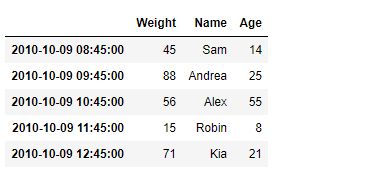Python Pandas DataFrame.to_records
Pandas DataFrame是一个二维的大小可变的,可能是异质的表格数据结构,有标记的axis(行和列)。算术操作在行和列的标签上对齐。它可以被认为是一个类似于Dict的系列对象的容器。这是Pandas的主要数据结构。
Pandas DataFrame.to_records()函数将DataFrame转换成NumPy记录数组。如果要求的话,索引将作为记录数组的第一个字段包括在内。
语法: DataFrame.to_records(index=True, convert_datetime64=None, column_dtypes=None, index_dtypes=None)
参数:
index : bool, default True
convert_datetime64 :如果是一个DatetimeIndex,是否将索引转换为datetime.datetime。
column_dtypes : 如果是一个字符串或类型,则存储所有列的数据类型。
index_dtypes : 如果是一个字符串或类型,则为存储所有索引级别的数据类型。
返回: numpy.recarray
示例#1:使用DataFrame.to_records()函数将给定的Dataframe转换成numpy记录数组。
# importing pandas as pd
import pandas as pd
# Creating the DataFrame
df = pd.DataFrame({'Weight':[45, 88, 56, 15, 71],
'Name':['Sam', 'Andrea', 'Alex', 'Robin', 'Kia'],
'Age':[14, 25, 55, 8, 21]})
# Create the index
index_ = pd.date_range('2010-10-09 08:45', periods = 5, freq ='H')
# Set the index
df.index = index_
# Print the DataFrame
print(df)
输出 :

现在我们将使用DataFrame.to_records()函数将给定的数据框架转换为numpy记录数组表示。
# convert to numpy record array
result = df.to_records()
# Print the result
print(result)
输出 :

正如我们在输出中看到的,DataFrame.to_records()函数已经成功地将给定的数据框架转换为numpy记录数组表示。
示例#2:使用DataFrame.to_records()函数将给定的Dataframe转换成numpy记录数组。
# importing pandas as pd
import pandas as pd
# Creating the DataFrame
df = pd.DataFrame({"A":[12, 4, 5, None, 1],
"B":[7, 2, 54, 3, None],
"C":[20, 16, 11, 3, 8],
"D":[14, 3, None, 2, 6]})
# Create the index
index_ = ['Row_1', 'Row_2', 'Row_3', 'Row_4', 'Row_5']
# Set the index
df.index = index_
# Print the DataFrame
print(df)
输出 :

现在我们将使用DataFrame.to_records()函数将给定的数据框架转换为numpy记录数组表示。
# convert to numpy record array
result = df.to_records()
# Print the result
print(result)
输出 :

正如我们在输出中看到的,DataFrame.to_records()函数已经成功地将给定的数据框架转换为numpy记录数组表示。
 极客教程
极客教程